A new book shedding light on the atrocities committed by the Chinese Nationalist Party (KMT) during the 228 Massacre was launched by the 228 Memorial Foundation yesterday
The book, titled The Truth About the 228 Incident and Transitional Justice Reports (二二八事件真相與轉型正義報告稿) is a follow-up to The 228 Incident: A Report on Responsibility (二二八事件責任歸屬研究報告), which was released 14 years ago and named former president Chiang Kai-shek (蔣介石) as the main culprit.
The 228 Massacre refers to a crackdown launched by the then-KMT regime against civilian demonstrators following an incident in Taipei on Feb. 27, 1947.
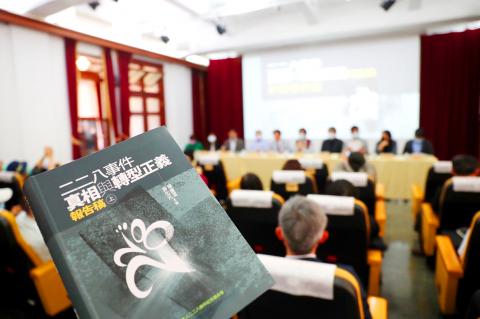
Photo: CNA
The massacre was a tragedy caused by state violence in the form of military suppression, and was filled with “illegitimacy and abuses of power,” as well as “unauthorized actions and a state of anarchy,” the new book said.
However, most military personnel that took part in the suppression were not held accountable, it said, adding that Chiang, who covered up, rewarded, or even promoted the perpetrators, is one of the main culprits behind the tragedy.
Part of the crackdown was launched by the Nationalist Army’s navy, including a political purge at Kaohsiung’s Zuoying oil refinery, where soldiers pillaged valuable items and shot some of the workers, it added.
Chiang deployed five naval vessels to boost the troops in Kaohsiung, the book said.
About two weeks into the massacre, military police departments became the government’s intelligence agencies, which carried out summary executions of political dissidents, it said.
Su Yao-tsung (蘇瑤崇), a Providence University professor who coauthored the book, said that fewer than 45 waishengren (外省人) were injured during the crackdown, adding that many of the books about the period have “exaggerated” the number of waishengren victims.
Inaccurate reporting, such as by the Central Daily News (中央日報), the mouthpiece of the then-KMT regime, which claimed that more than 400 waishengren were injured, was used to sow fear among the public and bolster the party’s authoritarian rule, Su said.
Academia Historica editor Ou Su-ing (歐素瑛), another coauthor, said that some regional heads were also culprits in the violence, including then-Hsinchu mayor Kuo Shao-tsung (郭紹宗), Chiayi mayor Sun Chih-chun (孫志俊) and Pingtung mayor Kung Lu-tuan (龔履端).
These officials were strongly opposed to the committees established by prominent residents to deal with the massacre’s aftermath — or sent troops to crack down on them, as they feared that the existence of military agencies in their jurisdiction would put them at a disadvantage, she said.
Fifteen out of 17 regional heads at the time were waishengren, and the other two — then-Taipei mayor Yu Mi-chien (游彌堅) and Kaohsiung mayor Huang Chung-tu (黃仲圖) — were benshengren (本省人) who had connections to China, Ou said.
Most of them were KMT members and considered unfit by local residents, while some had worked under then-Taiwan governor Chen Yi (陳儀).
Foundation chairman Hsueh Hua-yuan (薛化元) said that truth is essential for transitional justice, but that a great deal of information still needs to be uncovered.
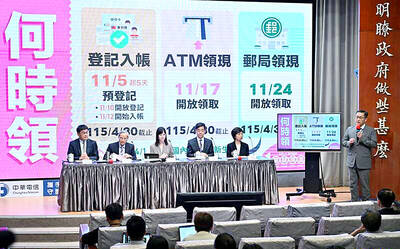
People can preregister to receive their NT$10,000 (US$325) cash distributed from the central government on Nov. 5 after President William Lai (賴清德) yesterday signed the Special Budget for Strengthening Economic, Social and National Security Resilience, the Executive Yuan told a news conference last night. The special budget, passed by the Legislative Yuan on Friday last week with a cash handout budget of NT$236 billion, was officially submitted to the Executive Yuan and the Presidential Office yesterday afternoon. People can register through the official Web site at https://10000.gov.tw to have the funds deposited into their bank accounts, withdraw the funds at automated teller
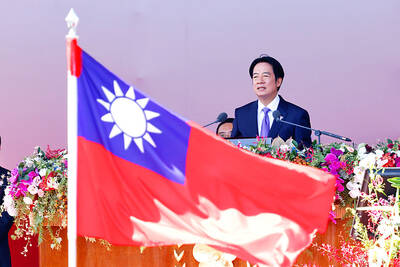
PEACE AND STABILITY: Maintaining the cross-strait ‘status quo’ has long been the government’s position, the Ministry of Foreign Affairs said Taiwan is committed to maintaining the cross-strait “status quo” and seeks no escalation of tensions, the Ministry of Foreign Affairs (MOFA) said yesterday, rebutting a Time magazine opinion piece that described President William Lai (賴清德) as a “reckless leader.” The article, titled “The US Must Beware of Taiwan’s Reckless Leader,” was written by Lyle Goldstein, director of the Asia Program at the Washington-based Defense Priorities think tank. Goldstein wrote that Taiwan is “the world’s most dangerous flashpoint” amid ongoing conflicts in the Middle East and Russia’s invasion of Ukraine. He said that the situation in the Taiwan Strait has become less stable
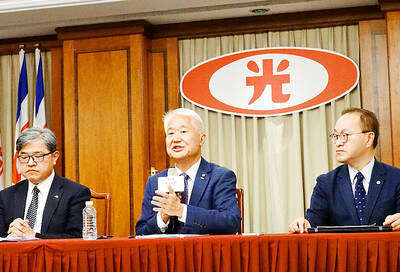
CONCESSION: A Shin Kong official said that the firm was ‘willing to contribute’ to the nation, as the move would enable Nvidia Crop to build its headquarters in Taiwan Shin Kong Life Insurance Co (新光人壽) yesterday said it would relinquish land-use rights, or known as surface rights, for two plots in Taipei’s Beitou District (北投), paving the way for Nvidia Corp to expand its office footprint in Taiwan. The insurer said it made the decision “in the interest of the nation’s greater good” and would not seek compensation from taxpayers for potential future losses, calling the move a gesture to resolve a months-long impasse among the insurer, the Taipei City Government and the US chip giant. “The decision was made on the condition that the Taipei City Government reimburses the related
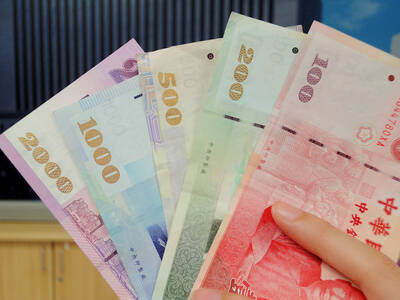
FRESH LOOK: A committee would gather expert and public input on the themes and visual motifs that would appear on the notes, the central bank governor said The central bank has launched a comprehensive redesign of New Taiwan dollar banknotes to enhance anti-counterfeiting measures, improve accessibility and align the bills with global sustainability standards, Governor Yang Chin-long (楊金龍) told a meeting of the legislature’s Finance Committee yesterday. The overhaul would affect all five denominations — NT$100, NT$200, NT$500, NT$1,000 and NT$2,000 notes — but not coins, Yang said. It would be the first major update to the banknotes in 24 years, as the current series, introduced in 2001, has remained in circulation amid rapid advances in printing technology and security standards. “Updating the notes is essential to safeguard the integrity